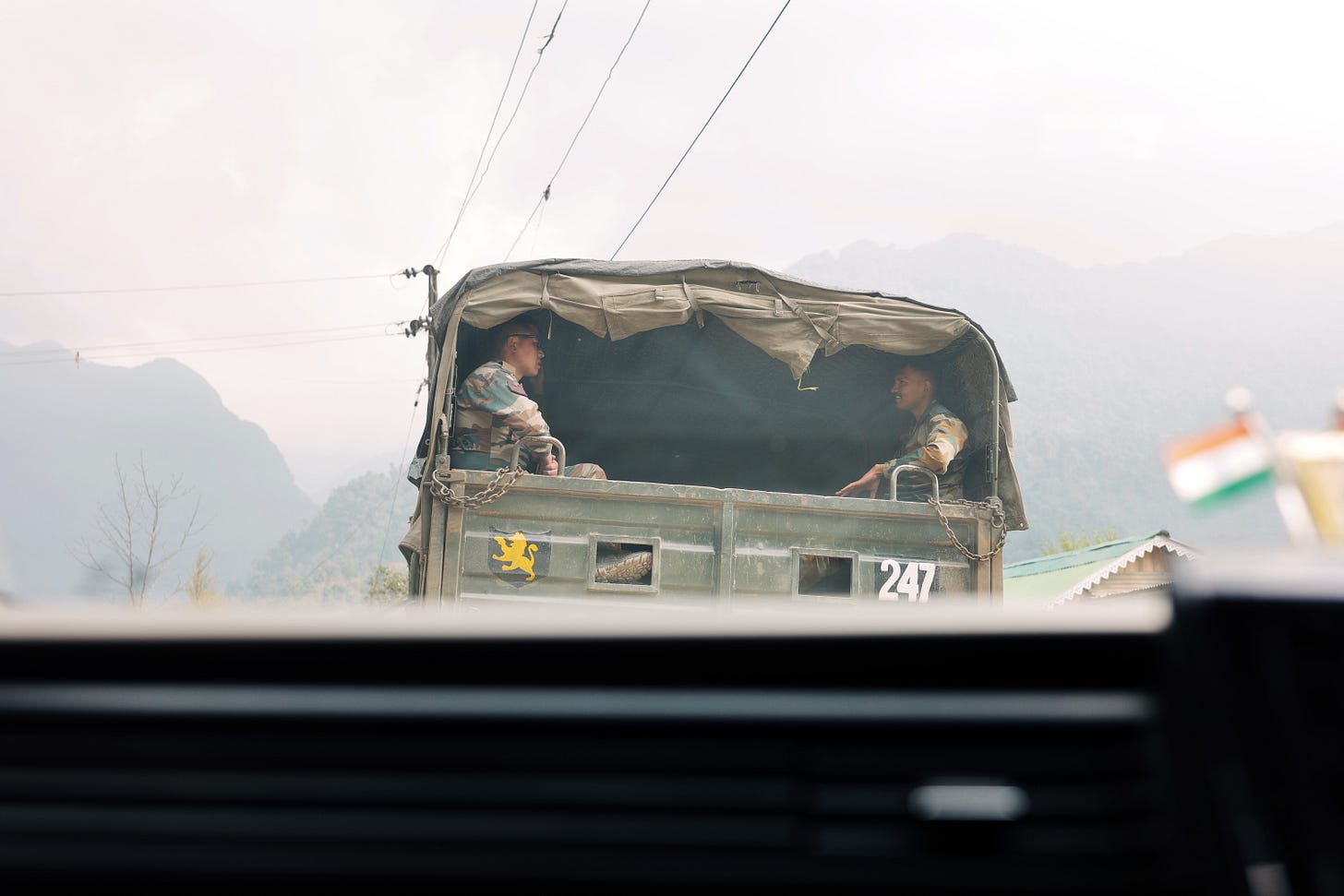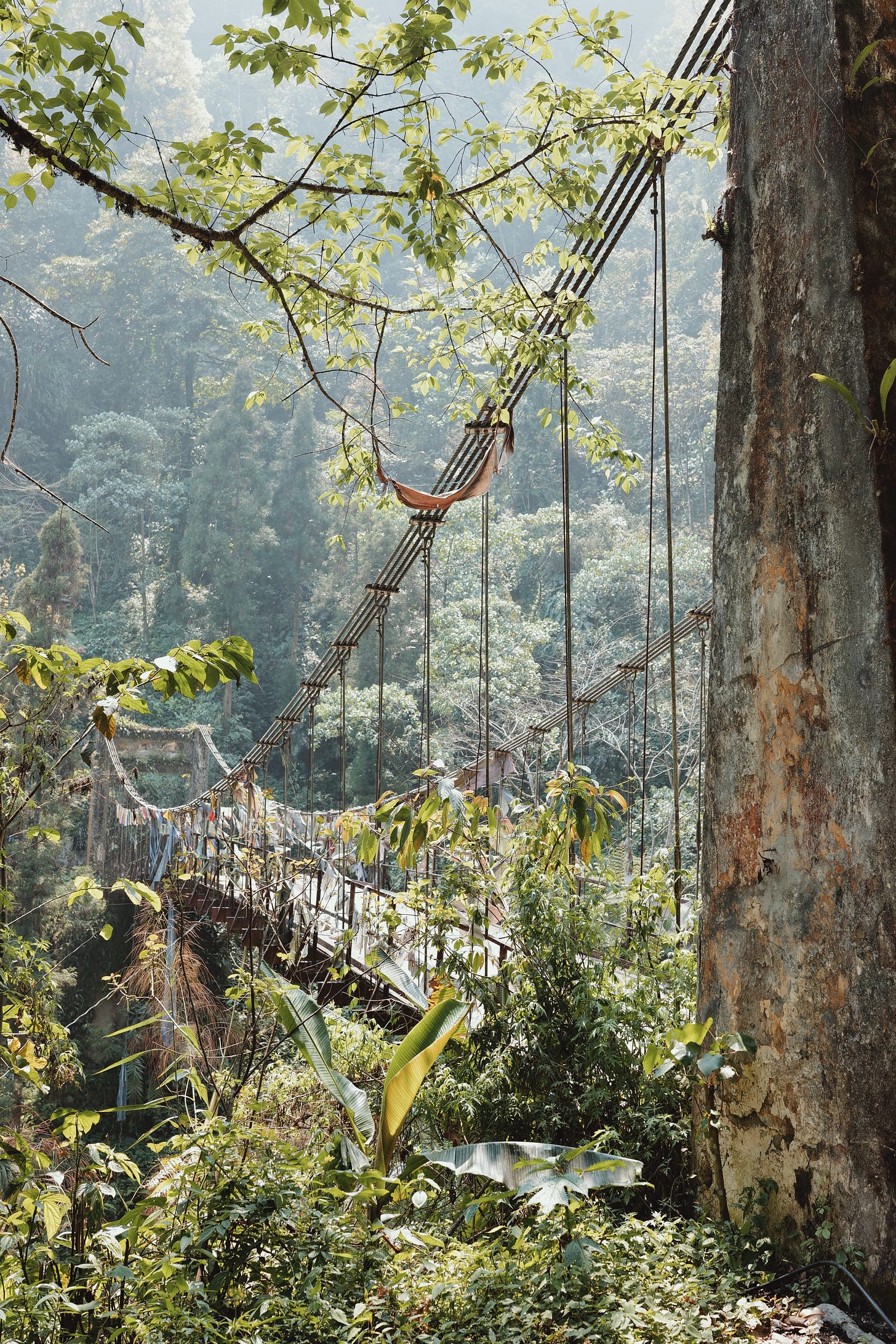Infinity Inkling #77
Himalayan Dispatch #2: Signs in High Places
Himalayan Dispatches is a travel series tracing my journey through Sikkim — India’s last Himalayan kingdom. It blends diary notes with photographs taken along the way. This is the second entry; you can read the first here. Subscribe to follow the rest, delivered straight to your inbox.1
Himalayan Dispatch #2: Signs in High Places
Monday, 25 March 2024. 7:30am.
Gangtok, Sikkim.
We set off early in a grey Dzire that — despite its name — wasn’t built for high-altitude ambition. The road to Tsomgo Lake and Nathu La climbs steadily, flanked by army posts, painted boulders, rusting road rollers, and a proliferation of signs that all begin with one word: BRO.
For a while, I assumed it was some quirky Gen Z copywriter’s campaign. BRO, better late than dead on time. BRO, don’t be a random on the road of wisdom. It took me longer than I’d like to admit to realize it was the Border Roads Organisation — the Ministry of Defence’s own road-building corps, which builds and maintains these impossible highways in equally impossible terrain.
Having done my fair share of Indian road trips, I’m no stranger to the country’s relationship with roadside messaging. But Sikkim’s border roads elevate the form to something stranger, more saturated, and almost self-aware. The signs, I realized, fall roughly into three categories.
First, the nationalist and martial:
Naam, Namak, Nishaan.2
I am a soldier. I fight where I am told, and I win where I fight.
I was an atheist until I met the God of War.
And nearer Nathu La pass — which connects Sikkim with the Chumbi Valley in Tibet — another rather ominous one read: You are under Chinese observation.
It wasn’t hyperbole. This stretch of road leads to one of the most tightly controlled and historically contested borders in Asia. Nathu La, sitting over 14,000 feet (4,300 metres) above sea level, is more than just a high-altitude checkpoint. It’s one of only a handful of open border crossings between India and China, and perhaps the most symbolically fraught.
The pass once formed part of the ancient Silk Route, linking traders from Lhasa to the plains of Bengal. Today, it marks the line where two nuclear-armed nations eye each other warily. India and China fought a war in 1962, and though the guns have largely fallen silent, the rivalry hasn’t — it simmers, sometimes flaring into brief clashes fought with sticks and stones in these icy heights.
But not all the signs speak the language of surveillance or war, for there are the safety sermons — morality plays I’d grown up seeing on highways across the country:
Fast drive could be last drive.
After whisky, driving risky.
If you are married, divorce speed.
One cat has nine lives. You have only one.
Go slow, your present will become your past in the future.
Even the speed of light is constant.
Speed has 5 letters. So does death.
But what felt the strangest were the motivational aphorisms — as if scribbled by a mountain monk raised on Instagram quotes:
Books are good for every mood.
Faith can move mountains.
Your life is limited. Don’t waste it living someone else’s life.
They’re at once absurd and oddly comforting, and together, they hint at the State’s psychological project in these remote hills — half reassurance, half assertion. A reminder that the Republic is watching, paving, protecting. Whether it’s meant for the Sikkimese, or for the mainland tourists flooding the region, is unclear. Probably both.
Monday, 25 March 2024. 10:55am.
Near Nathu La Pass.
About a kilometre short of the pass, we’re told to abandon our Dzire and shift into military-green 4x4s. They’re old, high-suspension jeeps that smell like engine oil and old leather. Twelve of us are packed into one. My parents squeeze up front by the driver, while I’m wedged in the back hold with a Punjabi couple who keep up a running commentary about every signboard and barrack we pass — until the man checks his phone and sees a message: Welcome to China.
He lets out a snort.
I glance at mine; my time zone has jumped two and a half hours ahead.
Indo-China rivalry, I think, playing out in cellular signals.
Tuesday, 26 March 2024. 8:00am.
Gangtok to Lachen.
The road to Lachen feels less like a highway and more like a negotiation — with altitude, stone, and time. Gurung, our driver, tells us we’re not on the usual route — in the 2023 flash floods, caused by a cloudburst that triggered a glacial lake outburst that broke one of the dams on the Teesta river, the main artery to North Sikkim was destroyed. We were, therefore, now riding the ribcage of the state’s newest workaround: a path carved from the debris of landslides and rebuilt, quite literally, before our eyes.
Every few kilometres, we see men and women from BRO bending over piles of loose rock, laying large, flat sheets of stone over old rubble, stitching road over rupture. There’s a particular precariousness in driving on a surface that still hints so clearly at prior calamity. Timing is everything. So is faith.
The inclines are steep. Every time the car hiccups, my heart does too.
At one wooden bridge, we’re made to wait. Only one car can go at a time. Two army men stand at either end, signalling when it’s safe to cross. Gurung doesn’t hesitate. He shifts gears and drives on, nonchalant, even as dozens of watchful eyes follow us from dashboards and windows. No performance anxiety, I think. The wheels click and clack across the planks like hooves on hollow ground. After what feels like the longest minute, we reach the other side — unscathed, save for the realization that we’re not even a fifth of the way to Lachen.
The thrill of danger loses its romance when you’re not twenty-two and alone, but thirty and travelling with your parents.
Loose stones and mounds of soft earth still line the edges, and one sign stops me in my tracks — Shooting Stones Possible — a phrase that sounds metaphorical until you realise it isn’t.
With every turn, I feel the air thin — slowly, imperceptibly, but surely. The sentences in my head get shorter. The landscape becomes quieter. Even the trees seem to know when to stop growing.
And yet, the Republic is everywhere. Not through flag-waving or slogans, but through presence — BRO workers hammering away at boulders, soldiers in camo manning the one-way bridges, guiding traffic through mud-streaked turns, helping rethread this fragile road into the mountains.
At one cantonment, a sign reads: Better to fight for something than to live for nothing.
There is no mistaking who built this road, who maintains it, and who is always watching.
Progress here comes at desi speed — slow, uneven, full of friction. But it moves. One bridge, one boulder, one breath at a time.
I’d promised myself (and you) that Infinity Inklings would be monthly now instead of weekly. But, as a certain reader reminded me recently — you know who you are — maybe once a month is too much of a wait. So here’s a biweekly update (yes, I caved!).
An honour code within the Indian army that literally translates to ‘Name, Salt, Mark’ which stands for respect, loyalty, and identity.








What a read man❤️❤️
I know who I am!